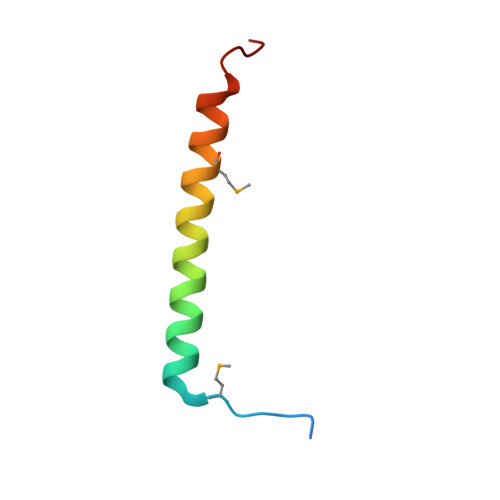Ring cycle for dilating and constricting the nuclear pore.
Solmaz, S.R., Blobel, G., Melcak, I.(2013) Proc Natl Acad Sci U S A 110: 5858-5863
- PubMed: 23479651
- DOI: https://doi.org/10.1073/pnas.1302655110
- Primary Citation of Related Structures:
4J3H - PubMed Abstract:
We recently showed that the three "channel" nucleoporins, Nup54, Nup58, and Nup62, interact with each other through only four distinct sites and established the crystal structures of the two resulting "interactomes," Nup54•Nup58 and Nup54•Nup62. We also reported instability of the Nup54•Nup58 interactome and previously determined the atomic structure of the relevant Nup58 segment by itself, demonstrating that it forms a twofold symmetric tetramer. Here, we report the crystal structure of the relevant free Nup54 segment and show that it forms a tetrameric, helical bundle that is structurally "conditioned" for instability by a central patch of polar hydrogen-bonded residues. Integrating these data with our previously reported results, we propose a "ring cycle" for dilating and constricting the nuclear pore. In essence, three homooligomeric rings, one consisting of eight modules of Nup58 tetramers, and two, each consisting of eight modules of Nup54 tetramers, are stacked in midplane and characterize a constricted pore of 10- to 20-nm diameter. In going to the dilated state, segments of one Nup58 and two Nup54 tetrameric modules reassort into a dodecameric module, eight of which form a single, heterooligomeric midplane ring, which is flexible in a diameter range of 40-50 nm. The ring cycle would be regulated by phenylalanine-glycine regions ("FG repeats") of channel nups. Akin to ligand-gated channels, the dilated state of the midplane ring may be stabilized by binding of [cargo•transport-factor] complexes to FG repeats, thereby linking the ratio of constricted to dilated nuclear pores to cellular transport need.
- Laboratory of Cell Biology, Howard Hughes Medical Institute, The Rockefeller University, New York, NY 10065, USA. ssolmaz@rockefeller.edu
Organizational Affiliation:


















